Adventure
 'I believe any trip in search of wildlife can be coupled with physical activity and elements of cultural diversity to form a thrilling opportunity ' 'I believe any trip in search of wildlife can be coupled with physical activity and elements of cultural diversity to form a thrilling opportunity '
John H.Eickert |
RAwhk! The raucous scream was hurled down to us from the canopy high above the brown chugging river where our canoe floated. RAwhk! The call came again, then the two large birds lifted
from the treetop and floated back deep into the forest.
I had hoped to see one of these birds in Costa Rica, but despite braving the biting flies and ants, the only thing I came away from the Oso Peninsula in Central America with was dehydration. Another year, I assembled with hundreds of
other tourists not far from Puerto Maldonado in Peru. The orange clay cliffs were covered with birds while below the river was crowded with tourists. It was not what I wished for.
And so, I tried again another year to find scarlet macaws I could spend time with, away from other tourists and not yet discovered by poachers. There is something about scarlet macaws, maybe their size, color, call, or like many birds
the fact that they mate for life. And like me, they prefer the deeper, quieter places, away from the hustle, bustle, bright lights, and noise of cities. The color. Well, these macaws have just as much blue color as they have red. Then there is that call. It
could be better described as a screaming screech and it can be heard for miles. I found the experience I wished for, be careful what you wish for!
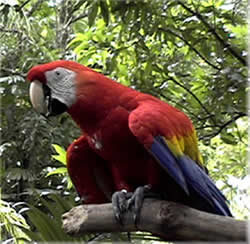 I flew to La Paz, capital of Bolivia in South America, then waited days to fly east and over the Andes to a river town called Rurrenabaque. In Rurrenabaque, I hired a young native man to guide me up river into a national park named
Madidi. With me were another adventure travel guide and a doctor, good friends to penetrate the deep jungle. On the third day we found scarlet macaws and then yellow macaws, more macaws than I have seen anywhere else I have ever been, and we were all alone.
By the fourth day, it became tiresome to point them out, as we put-putted up the brown river. On the morning of the fifth day our guide tried to get us to go back to Rurrenabaque, he said a ten-day trip would be too long and we would become sick. In the afternoon,
our guide pushed the boat over to the shore. He pointed into the forest. He would lead us into the forest to look for monkeys. We followed. We walked for an hour then sat down to watch the canopy. Before long, we spotted some monkeys and watched them feed.
I was curious and turned to ask a question of our guide. He was gone. We called for him. Nothing. There we were deep in the tight remote forest of Madidi, the darkest Amazon, and we were alone. And, we were lost. Could we, would we, ever find our way out and
back to civilization? I flew to La Paz, capital of Bolivia in South America, then waited days to fly east and over the Andes to a river town called Rurrenabaque. In Rurrenabaque, I hired a young native man to guide me up river into a national park named
Madidi. With me were another adventure travel guide and a doctor, good friends to penetrate the deep jungle. On the third day we found scarlet macaws and then yellow macaws, more macaws than I have seen anywhere else I have ever been, and we were all alone.
By the fourth day, it became tiresome to point them out, as we put-putted up the brown river. On the morning of the fifth day our guide tried to get us to go back to Rurrenabaque, he said a ten-day trip would be too long and we would become sick. In the afternoon,
our guide pushed the boat over to the shore. He pointed into the forest. He would lead us into the forest to look for monkeys. We followed. We walked for an hour then sat down to watch the canopy. Before long, we spotted some monkeys and watched them feed.
I was curious and turned to ask a question of our guide. He was gone. We called for him. Nothing. There we were deep in the tight remote forest of Madidi, the darkest Amazon, and we were alone. And, we were lost. Could we, would we, ever find our way out and
back to civilization?
Ah, but that’s another story. Hope each of you has found time for adventure! Cheers.
Visit http://www.numbum.net or call NumBum Adventurers at 406-777-2228
|
Answers To Quiz Of The Month
This month no one has given all right answers but mayank6676@rediffmail.com and navneet1@rediffmail.com have given 7 right answers.
Right Answer toQuiz on rivers/lakes originating in national parks/sanctuaries
|
| 1.The water bodies inside India’s forests have been assessed for the first time by |
|
The State of Forests Report, 2003 |
The Centrally Empowered Committee of the Supreme court |
The Tiger Task Force
|
|
| 2.An estimated ---------------------------sq.km of water bodies exist within the forested areas of the country. |
|
| 3.--------------------Tiger Reserve feeds the Tapi River supplying 30% of the fresh water requirement of the Vidharba area in Maharashtra |
|
| 4.The city of Tirunelveli in Tamil Nadu gets its water from the dam in |
|
Kalakad-Mundanthurai tiger reserve |
Bandipur |
Bhadra |
|
| 5.The town of Sawai Madhopur in Rajasthan gets its water through deep tube wells at the edge of the |
|
Ranthambore tiger reserve |
Bharatpur sanctuary
|
Sariska tiger reserve
|
|
| 6.Tulsi and Vihar lakes in the Sanjay Gandhi National Park and Tansa and Modak Sagar in Tansa wildlife sanctuary provide fresh water to the city of |
|
| 7.The Pench river whose catchment forests are part of the Pench tiger reserve is the main source of water supply to |
|
Raipur city |
Nagpur city |
Bhopal |
|
| 8.This is an important water body in Calcutta which is a unique mix of wetland and waterbody. The name is |
|
Suraj Kund |
Vikram Jheel |
Damdama Lake |
|
| 9.The total area of Sunderbans tiger reserve is 2585 sq.km of which ------sq.km covers water body |
|
585 sq.km |
285 sq.km |
985 sq.km |
|
| 10.India’s first of the 16 water transfer link projects was signed by Madhya Pradesh and U.P on 25 Aug.2005. This 2000 crore project links the rivers………. |
|
Parbati and KaliSindh
|
Parbati and Chambal
|
Ken and Betwa |
|
Please try this month quiz onglobal warming
|
Burning Issues
CHOKED EARTH
-Shivani Thakur
The incessant rains, which hit Mumbai, followed by recently caused floods in the city; the result was loss of innocent lives and damage to property worth many crores. If poor drainage system, almost 100 years old, was responsible for
it along with mismanagement by civic authorities, another major cause of floods was Mumbai’s plastic bags choking the city’s drainage system.
The Maharashtra government announced the decision to ban the use of plastic bags across the state after reviewing the situation. The state cabinet felt the need to ban the use and sale of the commodity in totality. But is ban in few
states the answer to the growing menace of the plastic bags?
India generates about 5,600 tonnes of plastic waste daily. Of which 60 percent is recycled into inferior products. The rest is tossed around to choke the environment. The use of plastic is not only limited to polythene bags or poly bags
but also plastic milk, oil and intravenous fluid pouches. Plastic has become a part of each household, both in form of packaging material and household equipment. Eliminating plastic bags is a desirable objective. But is this the solution when plastic has
invariably seeped into our lives.
Global wisdom suggests that it is important to look at the problem in multiple ways. The plastic bags not only choke the environment but also are hazardous to human as well as animal life. The food stored in poly bags gets contaminated
with toxic dyes, which are used to give color to the bags, which leak. The plastic toxicity results in drop in sperm count, genital abnormalities and breast cancer. Dioxin, a carcinogenic by-product, is passed on through breast milk to infants. Before the
government passed the specification of 20 microns thickness, the use of substandard and colored poly bags was the norm. A study conducted on their side effects resulted in bringing the 20 micron barometer to use. Their blatant use has not even spared the city
animals. The disposal of garbage is done in plastic bags. The street animals like stray cattle and dogs eat whole bags as they contain food. This has resulted in them developing tumors in their stomach or in a worst-case scenario death due to blocked airways.
To eliminate plastic bags, we have to create multiple disincentives. A ban can only work if the implementing agencies deliver. Although states like Goa, Kerala, Karnataka, Himachal and Sikkim have effectively banned the bags, the rest
of the nation still has a long way to go. In Karnataka the plastic waste is used for road construction. In Delhi bio-degradable plastic is mandatory for hospitals and hotels; but otherwise plastic bags thrive as their alternatives fail to compete. Besides,
the plastic and polymer industry have manipulated emerging policy on plastics. Their contention is that waste problem is by consumers, as against the industry, who do not dump the stuff into the bins.
The allegations and counter allegations will continue, as both the producer and the consumer are too responsible. The answer lies in making the producer liable to take back the waste for recycling, although only an inferior product will
result. Consumers should be offered a choice between plastic and its alternatives. Plastic like PVC that are suspected to be toxic should be phased out within a time frame. Incentives and support for alternative materials is essential. The need to establish
state of art plastic down cycling plant for some type of non-toxic plastics is essential. The lesson to be learnt from Mumbai floods is not to wait for a situation to develop in each region before taking action but benefit from the Mumbai experience which
is as an eye opener.
Photo courtesy-Times News Network
------------------------------------------------------------------------------------------------------------
NOTE: Use of shredded plastic waste acts as a strong ‘binding agent’ for tar, making asphalt to last long. The civic body in Bangalore has used plastic waste to asphalt over 300km of road so far.( example-Ring Road from
Deve Gowda petrol bunk to Kanakpuraad 6.8km )
Over 140 km along 41 roads will be upgraded at a cost of Rs.140 crores under the Karnataka Municipal Reforms Project this year
|
Common Birds of India
By -
Ragoo Rao
 A close cousin of the pigeon but a little smaller in size, these pinkish brown birds with grey upper parts with a typical black and white spotted patch on their nape are very shy and peace-loving birds. The only way to know their
presence is by their Kroooo...kruk...krooo..kurooo...sounds. They are very wary of human presence and at the slightest noise flap away with a whirring whistle of their wings. Always found in pairs; both sexes look alike. A close cousin of the pigeon but a little smaller in size, these pinkish brown birds with grey upper parts with a typical black and white spotted patch on their nape are very shy and peace-loving birds. The only way to know their
presence is by their Kroooo...kruk...krooo..kurooo...sounds. They are very wary of human presence and at the slightest noise flap away with a whirring whistle of their wings. Always found in pairs; both sexes look alike.
Distribution is almost through out the country except for very arid regions. They inhabit open wooded places and are often found very close to cultivated fields. These birds can get very familiar with the farmers if not disturbed
and molested. On gaining confidence these birds would even fly down from their perches to pick up grains when thrown at them.
On cloudy days in cultivated fields, specially during mid-day, one could hear their pleasant Kroooo....kruk...kruk...krooooo which could be so soothing to a nature lover.
Nesting is almost through out the year, pronounced when food is abundant. The nesting site is usually in a thorny low tree or a bush. The nest is a clumsily made mass of sticks, lined with fine grass and their own feathers. Sometimes
even abandoned buildings are chosen for nesting in niches in their walls close to the roofs. Two white eggs, slightly smaller than the pigeon's are laid and both sexes share all domestic chores. The chicks which are blind and covered by scanty off-white down
feathers grow up rapidly and in about three weeks they are ready for flight. These young birds hang around their parents for some more time begging for food in their characteristic pigeon like way, flapping their wings close to their bodies with a begging
Chee....cheeee...sounds.
(Photo: Spotted Dove by Ragoo Rao)
|
Did You Know ?
|
S.Ananthanarayanan recalls a news report of conservation groups protesting about the effects of the US navy’s sonar on marine life, especially whales.
|
Can sound waves in the sea affect marine life?
Sound in water?
Eardrums, or things like microphones, detect sound by being put into physical vibration by sound waves striking them. If the waves are low frequency, we hear a deep sound, and if the frequency is high, we hear a shrill sound.
We usually hear sound waves in air, but those of us who swim may have noticed that we can hear things even when under water. This happens when the sound waves set the water vibrating and the water transmits the wave motion to our ears.
It is the same if the source of vibrations were within the water, because water is as effective a medium to carry mechanical vibrations as air.
The nature of sonar
Sonar is a way to detect things by listening to sound reflecting off them. Using light as a detector has its advantages and limitations. For example, to pass through the vacuum of space, or for the details that most animals need to see,
it is only light that can fit the bill. But for use to detect things over a distance on the earth, a chief disadvantage is its limited range.
Sound waves, on the other hand, travel freely in air or water. Bats, for instance, which need to detect obstacles or moving prey, at night, can use high frequency sound, as a ‘searchlight’. The range of interests is just tens of metres,
and if the frequency is high, the reflection contains enough detail for the bats purpose.
When the range is a few kilometres, like in the communication needs of elephant herds, low frequency sound is effective, it conveys less detail, but carries long distances. But it is still no good for distances over a few kilometers.
For aviation, for instance, it is RADAR, which is a very low frequency light wave that needs to be used.
But in water, sound waves have pretty good range, while light or radio waves have practically none. Hence, using a source of sound, and listening for the echo, is the method of whales and dolphins and also of submarines or ships looking
for things under water.
The US navy
Sonar still has only a few kilometers range, in water. But the US navy would like to detect things tens or even hundreds of kilometers away. So they do two things, one is to use real low frequency sound, which has the longest range,
and then, they use real loud sounds!
Low frequencies fall right into the range that whales and dolphins use, and to which their ears are the most sensitive. And when a submarine blasts the sea with a sound to carry a hundred kilometers, one can imagine what this would do
to those in earshot!
Conservationist groups found that post-mortem of hundreds of whales, beached in the Bahamas , showed signs of bleeding within the inner ear and the groups have raised protests against the US navy.
[The writer can be contacted by E-mail at:
simplescience@gmail.com ]
|
Gardening for wildlife
-Promila Chaturvedi
The rose, known for its beauty: shape colour and fragrance, is not very difficult to grow. Only one has to plant it in the correct environment and prune it in time and take proper care of it; Protect it against diseases and pests that
attack the rose bush. It is advisable to buy the plants from a reputed nursery.
Which rose to buy
All that depends on your requirement, that is, what effect you want ; whether you like to have lots of flowers and do not care for the shape and size, in that case you may have clustered flowerFloribunda roses. In case
shape and size of flowers matters much more than the number of blooms you should haveHybrid Tea roses.
Colour and fragrance are also a personal choices.
In case you have a big garden you can have a combination of both Hybrid Tea and Floribunda roses.
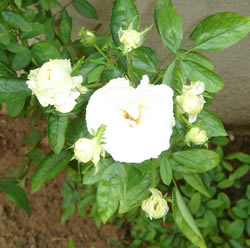
When to plant
Roses can be planted either in the rainy season or October onward through out winter till February. Buy healthy plants with three or more shoots from the graft. The plant should be free of pests and should have a well developed root
system.
Preparation of rose bed
Mark the bed size and shape on ground. If the ground is too dry water it before digging. First dig one foot deep and keep the soil aside. Dig another foot deep and keep separately. Now dig one foot more and discard it. Spray bottom and
all four side of bed with insecticide thoroughly. Now the second heap of soil should be mixed with soil conditioners and fill it in the bottom. Water it. Fill the top soil in the bed and again water it. When ground is in working condition dress it and mark
the position of plant and scoop out slightly more soil in depth and width than the root ball or if you intend planting bare root plant than slightly larger pit hole be made and do the planting.
Soil conditioners
It is better to use organic manure. Gypsom 2kg, Neem Oil cake 2kg, Bone Meal 2kg and one third of total quantity of soil should be Farm Yard Manure. It should be mixed with the bottom layer of soil.
Pruning
Pruning should be done in the beginning of October when weather starts cooling. In first year almost no pruning is needed, if any pruning has to be done it should be very light. Medium pruning and heavy pruning should be done with old
plants.
(Photo: Iceberg floribunda-Susan Sharma)
|
Story Of The Month
-Mahavir Nimavat,
11 th Science,
St.Xavier’s High School,
Gandhinagar.
Last month, a nature education camp was organized by the Gandhinagar unit of “Youth Hostels of India” atRatan Mahal Wild Life Sanctuary on 13, 14, and 15 th of August. Ratanmahal is situated in Dahod district. Previously
the jungle was owned by the Maharaja of Devgadh Baria. It was declared a sanctuary in 1982. Ratanmahal harbors maximum population of Sloth Bears in the state. More over, it possesses a rich treasure of flora and fauna. Leopards, Hyena, Chausinga and Porcupine
are the main animals. Cobra, Krait, Russell’s viper, Saw scale Viper and Bamboo Pit Viper are also found there. The pristine beauty the forest in this small tract with rugged topography gives a feel of a hill station.
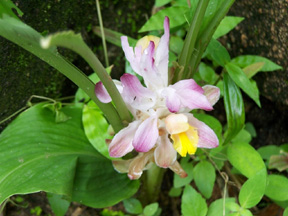 The sanctuary area is small – only 65.55 sq.kms. However, the diversity is enormous. Some patches are lush green throughout the year. In addition, the beauty of the forests after few inches of rain, glows enchantingly. The sanctuary area is small – only 65.55 sq.kms. However, the diversity is enormous. Some patches are lush green throughout the year. In addition, the beauty of the forests after few inches of rain, glows enchantingly.
A group of 60 students participated in the camp. The journey started on the noon of the 13 th of august. After covering distance of 280 kms by a luxury coach, we reached there at 6:30 pm. Accommodation was arranged at an Ashram Shala
at Kanjeta, a village neighboring the sanctuary. Ashram Shala is a residential school for tribal kids.
On the first evening, there was a small talk about nature conservation, jungle discipline and the details about the sanctuary followed by a trek to river Paanam. Paanam is the main lifeline of Dahod and Panchmahal districts. Its catchment
area falls in Ratanmahal.
After dinner, there was a short trek. It was an exciting experience to walk through small trails under moon light. While on the trek we saw a Krait, the most venomous snake of our state. Suddenly some movement was noticed on an almond-tree;
there were two flying foxes fighting for food. All the participants saw them in torch light and were given information about the only flying mammal.
On the next day morning, after break fast the group started for Ratneshwar Mahadev. The trek is stiff and the distance is 9.5 kilometers from the base. But we all enjoyed the real beauty of jungle. Chirping of birds and the sweet sound
of air passing through bamboo canopies was mind blowing. At the foothills, dry deciduous teak forest is situated and at the periphery, there are beautiful dense bamboo bushes. As we climbed higher, we passed through a green patch of Arjun (sadad). Arjun is
very useful in cardiac disease. It is a peculiarity of this forest that most of the jungle is covered by pure patches of tree species like timroo, kada, arjun, jamun and aamla. 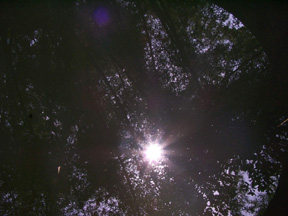
Due to heavy rain in the last few days, streams were flowing; green bushes covered all the land. The diversity of flora of this area is very rich and so is the insect life. We reached the top at 12:30 pm. All the fatigue of a long and
stiff trek was gone with just a one glance of the breath taking beauty of the scene. We were at the top, surrounded by green hills. The atmosphere was cool and cloudy. We also saw a stonewall demarcating Gujarat from Madhya Pradesh. After taking lunch, there
were some talks about water preservation and information about sloth bears. Then the group started dismounting. During the trek back, we saw many birds like Crested Serpent Eagle, Paradise Fly catcher, Small Minivet, Fantailed Fly catcher, Indian Robin, Tree
Pie, Lesser Golden backed Woodpecker etc. While trekking back, the group collected four bags full of plastic and polythene waste.
In the evening, there was an interaction with local tribal children who are staying at Ashram Shala. After dinner there was a combined cultural program performed by camp participants and tribal children.
On the last day of the camp, we attended a flag-hoisting program at the ashram shala. Then went for a trek to ‘Rohat’ waterfall. The trek was very nice, stiff and zigzag passing thru a thick, green jungle. We climbed, climbed, and suddenly
saw a stunning scene. The water falls from a height of 200 feet in many streams. In addition, a straight valley on both sides of the fall is a rare scene here in Gujarat.
We went back to the base and had lunch. Took few photographs with the children and started our return journey towards Gandhinagar.
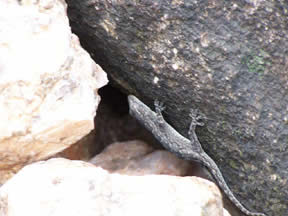 It was an unforgettable experience for all the participants who saw various facets of nature and learnt many new things about nature and wild life. We are thankful to Chaitanya sir who taught us many good things, which are very important
for our life. It was an unforgettable experience for all the participants who saw various facets of nature and learnt many new things about nature and wild life. We are thankful to Chaitanya sir who taught us many good things, which are very important
for our life.
( Photo: Wild Flower, Sun through Bamboos and Rock Gecko by Chaitanya)
( This report was sent by Chaitanya who is managing the Gandhinagar unit of “ Youth Hostels of India”, a Government of India initiative)
|